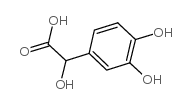Mechanistic studies on tyrosinase-catalysed oxidative decarboxylation of 3,4-dihydroxymandelic acid.
M Sugumaran, H Dali, V Semensi
文献索引:Biochem. J. 281 ( Pt 2) , 353-7, (1992)
全文:HTML全文
摘要
Mushroom tyrosinase, which is known to convert a variety of o-diphenols into o-benzoquinones, has been shown to catalyse an unusual oxidative decarboxylation of 3,4-dihydroxymandelic acid to 3,4-dihydroxybenzaldehyde [Sugumaran (1986) Biochemistry 25, 4489-4492]. The mechanism of this reaction was re-investigated. Although visible-region spectral studies of the reaction mixture containing 3,4-dihydroxymandelic acid and tyrosinase failed to generate the spectrum of a quinone product during the steady state of the reaction, both trapping experiments and non-steady-state kinetic experiments provided evidence for the transient formation of unstable 3,4-mandeloquinone in the reaction mixture. The visible-region spectrum of mandeloquinone resembled related quinones and exhibited an absorbance maximum at 394 nm. Since attempts to trap the second intermediate, namely alpha,2-dihydroxy-p-quinone methide, were in vain, mechanistic studies were undertaken to provide evidence for its participation. The decarboxylative quinone methide formation from 3,4-mandeloquinone dictates the retention of a proton on the alpha-carbon atom. Hence, if we replace this proton with deuterium, the resultant 3,4-dihydroxybenzaldehyde should retain the deuterium present in the original substrate. To test this hypothesis, we chemoenzymically synthesized alpha-deuterated 3,4-dihydroxymandelic acid and examined its enzymic oxidation. Our studies reveal that the resultant 3,4-dihydroxybenzaldehyde retained nearly 90% of the deuterium, strongly indicating the transient formation of quinone methide. On the basis of these findings it is concluded that the enzymic oxidation of 3,4-dihydroxymandelic acid generates the conventional quinone product, which, owing to its unstability, is rapidly decarboxylated to generate transient alpha,2-dihydroxy-p-quinone methide. The coupled dienone-phenol re-arrangement and keto-enol tautomerism of this quinone methide produce the observed 3,4-dihydroxybenzaldehyde.
相关化合物
| 结构式 | 名称/CAS号 | 分子式 | 全部文献 |
|---|---|---|---|
 |
DL-3,4-二羟基杏仁酸
CAS:14883-87-5 |
C8H8O5 |
|
Lipophilicity of amine neurotransmitter precursors, metaboli...
2014-10-01 [J. Chromatogr. Sci. 52(9) , 1095-103, (2014)] |
|
Further study on the use of uncharged beta-cyclodextrin poly...
1995-08-01 [Electrophoresis 16(8) , 1505-9, (1995)] |
|
Chemical and enzymic oxidation by tyrosinase of 3,4-dihydrox...
1988-12-01 [Biochem. J. 256(2) , 681-4, (1988)] |
|
Oxidative decarboxylation of 3,4-dihydroxymandelic acid to 3...
1991-04-29 [Biochim. Biophys. Acta 1077(3) , 400-6, (1991)] |
|
3,4-Dihydroxymandelic acid, a noradrenalin metabolite with p...
2002-10-09 [J. Agric. Food Chem. 50(21) , 5897-902, (2002)] |